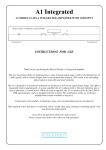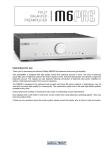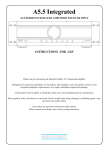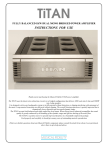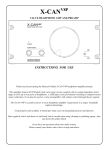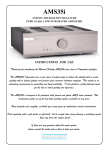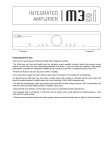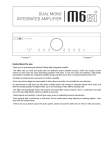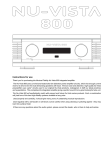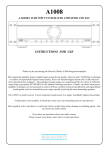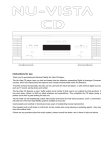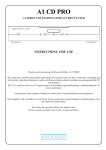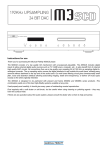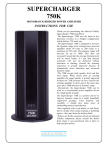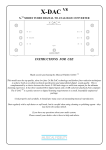Download Musical Fidelity M8 500S Specifications
Transcript
Instructions for use
Thank you for purchasing the Musical Fidelity M8 Preamplifier fully balanced dual mono pre-amplifier.
This preamplifier is designed with high quality control and especially balanced sources in mind.
Two balanced (XLR) inputs take care of balanced audio for the best in signal to noise, transient reproduction
and dynamic range from balanced sources. Inside, the balanced signal path is fully maintained, from input to
output, with a specially developed dual mono fully balanced preamplifier circuit.
The balanced volume control is a quad laser-trimmed attenuator giving 0.5dB steps of perfect matching,
allowing precise stereo imaging and ultra-low noise and distortion. The outputs are also balanced allowing
connection of balanced input power amplifiers to realise a completely balanced system from source to
speakers.
Units with single – ended (RCA) inputs and outputs are catered for with 6 selectable RCA inputs, and two sets
of outputs, one fixed for recording, etc, the other is the main controlled output.
The M8 Preamplifier has been designed to mix-and-match input/output signal types and use the unit as a single
ended to balanced (or vice versa) converting preamplifier. It is also designed to allow use of both balanced and
single ended outputs, simultaneously, if required.
All conversions are carried out automatically within the unit, all that needs to be done is choose and connect
the correct input and output leads.
The M8 Preamplifier is designed to be partnered with present and future M8 or M6 series products or
alternatively, may be used with any other high quality hi-fi components. This combination yields one of the best
high-fidelity systems available at any price.
Used properly and carefully, it should give many years of outstanding musical reproduction.
Dust regularly with a soft duster or soft brush, but be careful when using cleaning or polishing agents - they may
harm the surface finish.
If there are any questions about the audio system, please consult the dealer who is there to help and advise.
CONTENTS
Section
Page
–
Mains plug (UK only)
–
Modification warning
General advice
–
Installation precautions & user information
4
Disposal information
–
EU disposal information
5
Installation
–
Introduction, cleaning, installation, power connections, audio
connections
6
Facilities and connections
–
Illustrations, main unit front & rear panels
7
Remote control handset
–
Operation and illustration
8
Operation
–
Starting,
9
–
Volume
–
Mute
–
PHONO
–
CD
–
TUNER
–
AUX1
–
AUX2/HT
–
TAPE
–
TAPE MONITOR
–
BALANCED 1/HT
–
BALANCED 2
–
Basic fault finding
Safety Information
Problems?
3
10
11
Specifications
12
Manual history
13
Issue 2
Page 2 of 13
SAFETY INFORMATION
IMPORTANT! (U.K. only)
This unit is supplied in the U.K. with mains lead fitted with a moulded 13 amp plug. If, for any reason, it is
necessary to remove the plug, please remove the fuse holder and dispose of the plug safely, out of reach of
children.
It must not be plugged into a mains outlet.
The wires in the mains lead supplied with this appliance are coloured in accordance with the following code:
Green and yellow ............................. Earth
Blue................................................ Neutral
Brown ................................................. Live
WARNING – This appliance MUST be earthed
As the colours of the wires of the mains lead of this appliance may not correspond with the coloured markings
identifying the terminals in the plug, proceed as follows:
•
The wire which is coloured green-and-yellow must be connected to the terminal in the plug which is marked
with the letter E or coloured green or green-and-yellow, or by the earth symbol:
•
The wire which is coloured brown must be connected to the terminal which is marked with the letter L or
coloured red.
•
The wire which is coloured blue must be connected to the terminal which is marked with the letter N or
coloured black.
•
If connecting to a BS1363 plug, a 13 amp fuse must be used.
WARNING:
ANY MODIFICATIONS TO THIS PRODUCT NOT EXPRESSLY
APPROVED BY MUSICAL FIDELITY WHO IS THE PARTY RESPONSIBLE
FOR STANDARDS COMPLIANCE COULD VOID THE USER'S
AUTHORITY TO OPERATE THIS EQUIPMENT.
Issue 2
Page 3 of 13
GENERAL ADVICE
Installation precautions & user information
This new M8 Preamplifier is designed and built to provide trouble-free performance, but as with all electronic
devices it is necessary to observe a few precautions:
•
Heed all warnings shown on the back of the product.
•
Only connect the M8 Preamplifier to a mains outlet having the same voltage as marked at the back of the
unit.
•
Always ensure that when disconnecting and reconnecting your audio equipment the mains supply is
switched off.
•
Position the mains lead and signal interconnects where they are not likely to be walked on or trapped by
items placed on them.
•
Do not use near water, or place water-filled containers on the M8 Preamplifier, for example, a flower vase or
potted plants. If water does spill inside, immediately pull out the mains plug from the wall socket and
inform your dealer, who should then check the unit before further use. Entry of liquid into the M8
Preamplifier is dangerous, and may cause electric shock or fire hazard.
•
Do not place the unit near direct heat sources such as radiators, direct sunlight or other equipment.
•
Do not remove any covers or try to gain access to the inside. There are no internal adjustments or fuses you
can replace yourself. Refer all service work to an authorised Musical Fidelity agent.
* Note: Unauthorised opening of the equipment will invalidate any warranty claim.
•
Dust regularly with a soft cloth or soft brush but be careful when using cleaning or polishing agents - they
may harm the surface finish.
The electronics in modern hi-fi equipment is complex and may, therefore, be adversely affected or damaged by
lightning. For protection of the audio system during electrical storms, remove the mains plugs.
If after-sales service is required, to help the dealer identify the M8 Preamplifier please quote the serial number
located on the rear panel of the unit.
Issue 2
Page 4 of 13
ITEM DISPOSAL INFORMATION
DISPOSAL
The crossed out wheeled bin label that appears on the back panel of the product indicates that
the product must not be disposed of as normal household waste. To prevent possible harm to the
environment please separate the product from other waste to ensure that it can be recycled in an
environmentally safe manner. Please contact local government office or retailer for available collection
facilities.
DISPOSITION
La poubelle sur roulettes barrées X, qui apparaît en logo sur le panneau arrière du produit, indique que celui-ci ne
doit pas être traité comme un déchet domestique commun. Afin de protéger l'environnement, ce produit électronique devra
être géré séparément et donc recyclé selon les nouvelles normes Européennes Rohs concernant les déchets d'appareils
électroniques. Prière de contacter les services concernés gouvernementaux ou votre point de vente pour l'élimination et
l'enlèvement de déchets électroniques équipés de composants électroniques.
DISPOSAL
La etiqueta cruzada hacia fuera del compartimiento que aparece en el panel trasero del producto indica que el
producto no se debe reciclarse como basura normal de la casa. Para prevenir daños posible al ambiente separe por favor el
producto de otras basura para asegurarse de que puede ser reciclada de una manera ambientalmente segura. Entre en
contacto por favor a su oficina gubernamental local o a su minorista para las instalaciones disponibles de la colección.
RIFIUTI
L'etichetta del cassonetto barrato riportato sul retro dell'apparecchio indica che il prodotto non deve essere
smaltito tramite la procedura normale di smaltimento dei rifiuti domestici. Per evitare eventuali danni all'ambiente, separare
questo prodotto da altri rifiuti domestici in modo che possa venire riciclato in base alle procedure di rispetto ambientale. Per
maggiori dettagli sulle aree di raccolta disponibili, contattate l'ufficio govenativo locale od il rivenditore del prodotto.
FACHGERECHTE ENTSORGUNG:
Das auf der Geräterückseite angebrachte Label deutet darauf hin, dass das Produkt nicht mit konventionellem
Hauskehricht entsorgt werden darf. Um Schäden und Verschmutzungen an Umwelt und Mensch zu vermeiden, muss das
Produkt fachgerecht entsorgt und von anderem Abfall getrennt werden. Wenden Sie sich bei Fragen hierzu an Ihren
Fachhändler oder an eine öffentliche Informationsstelle.
AFVAL
Het label op de achterzijde van dit apparaat, een afvalbak op wielen met een kruis doorgehaald, geeft aan dat dit
apparaat niet samen met gewoon huishoudafval mag worden weggegooid. Om mogelijke schade aan onze leefomgeving te
voorkomen dient dit apparaat, gescheiden van gewoon huishoudelijk afval, te worden afgevoerd zodat het op een
milieuvriendelijke manier kan worden gerecycled. Neem voor beschikbare inzamelplaatsen contact op met uw gemeentelijke
reinigingsdienst of met uw elektronica leverancier.
HÄVITTÄMINEN
Yliruksattua jäteastiaa kuvaava tarra tuotteen takalevyssä kertoo, että tuotetta ei saa käsitellä normaalina
talousjätteenä. Ympäristön suojelemiseksi on tuote pidettävä erillään muusta jätteestä ja se on kierrätettävä ekologisesti
kestävällä tavalla. Ota yhteyttä laitteen myyjään tai Pirkanmaan Ympäristökeskukseen lähimmän kierrätyskeskuksen
löytämiseksi.
AFSKAFNING
Logoet med en skraldespand med kryds over på bagsiden af apparatet indikerer at dette produkt ikke må kasseres
som normal husholdningsaffald. For at forebygge mulig skade på miljøet, bedes De separere dette produkt fra andet affald,
og sikre at det bliver genbrugt på en miljørigtig måde. Kontakt venligst de lokale myndigheder eller din forhandler for
oplysning om nærmeste tilgængelige opsamlingssted for elektronikaffald.
∆ΙΑ∆ΙΚΑΣΙΑ ΑΠΟΡΡΙΨΗΣ
ΤΟ ΣΗΜΑ ΜΕ ΤΟΝ ∆ΙΑΓΕΓΡΑΜΜΕΝΟ ΤΡΟΧΗΛΑΤΟ ΚΑ∆Ο ΑΠΟΡΡΙΜΑΤΩΝ ΣΤΗΝ ΠΙΣΩ ΟΨΗ ΤΟΥ
ΜΗΧΑΝΗΜΑΤΟΣ
∆ΗΛΩΝΕΙ ΟΤΙ ΤΟ ΠΡΟΙΟΝ ΑΥΤΟ ∆ΕΝ ΠΡΕΠΕΙ ΝΑ ∆ΙΑΧΕΙΡΙΣΘΕΙ ΣΑΝ ΣΥΝΗΘΙΣΜΕΝΟ ΟΙΚΙΑΚΟ ΑΠΟΒΛΗΤΟ.
ΠΡΟΣ ΑΠΟΦΥΓΗ ΕΝ∆ΕΧΟΜΕΝΗΣ ΕΠΙΒΑΡΥΝΣΗΣ ΤΟΥ ΠΕΡΙΒΑΛΛΟΝΤΟΣ, ΞΕΧΩΡΙΣΤΕ ΤΟ ΠΡΟΙΟΝ ΑΠΟ ΤΑ ΑΛΛΑ
ΑΠΟΡΡΙΜΑΤΑ ΩΣΤΕ ΝΑ ΕΞΑΣΦΑΛΙΣΘΕΙ Η ΑΝΑΚΥΚΛΩΣΗ ΤΟΥ ΜΕ ΤΟΝ ΠΡΕΠΟΝΤΑ ΤΡΟΠΟ.
ΠΑΡΑΚΑΛΟΥΜΕ ΝΑ ΕΠΙΚΟΙΝΩΝΗΣΕΤΕ ΜΕ ΤΗΝ ΤΟΠΙΚΗ ΥΠΗΡΕΣΙΑ ΑΝΑΚΥΚΛΩΣΗΣ Η ΜΕ ΤΟ ΚΑΤΑΣΤΗΜΑ ΑΓΟΡΑΣ
ΓΙΑ ΠΕΡΙΣΣΟΤΕΡΕΣ ΛΕΠΤΟΜΕΡΕΙΕΣ.
Issue 2
Page 5 of 13
INSTALLATION
Introduction
Congratulations on the purchase of the new M8 Preamplifier. Great attention has been paid to internal layout,
isolating each circuit section to prevent possible interaction.
The unit features a high precision fully balanced preamplifier, for smooth sound coupled with low noise and
virtually no distortion.
The preamplifier consists of two monoblock balanced amplifiers with generously rated supplies for the absolute
best in separation and imaging. Low distortion and very quiet they will deliver all music types exactly as the
artist originally intended.
The resultant performance achieved by this unit is among the best in the world. It has excellent signal to noise
ratio, low distortion, wide bandwidth and dynamic range, with extraordinary resolution and fine detail.
Cleaning
Before cleaning the unit, switch off power at the mains switch and remove the mains plug from the wall socket.
Clean the cabinet and remote control unit using a moist cloth. Using solvents, white spirit or thinners is not
advised, as they could damage the surface finish.
Installation
Position the M8 Preamplifier on a stable, horizontal surface where there is no risk of it being knocked, or
subjected to vibration such as from loudspeakers.
Important note:
The M8 Preamplifier must be protected from humidity – if the unit is moved from a cold place to a
warm room, leave the unit for an hour or so to allow sufficient time for the moisture to evaporate.
Power Connections
The M8 Preamplifier is supplied with a standard IEC mains cable which plugs into the IEC socket at the back of
the unit (see page 7)
Audio Connections
RCA Inputs: Connect all RCA single-ended sources to relevant analogue inputs (see page 7 for more
information). Use good quality fully connected (signal and ground) coaxial phono cables for all RCA signal
connections.
XLR Inputs: Connect any XLR balanced source to desired balanced analogue inputs (see page 7 for more
information). Use good quality fully connected (signals and ground) balanced XLR cables for all XLR signal
connections.
Phono Input: Connect a turntable with MM or MC type cartridge to the M8 Preamplifier phono input to allow
audio from turntable to be heard through the hi-fi. Use a good quality well-screened phono cable for very best
results. Keep the phono leads as far away as possible from mains leads, plugs and sockets to avoid unwanted
hum pickup!
TAPE Output: Direct loop through of selected source. The level of this output is unaffected by the volume
control, to pass on to a recorder or other equipment. It is also the ideal output for standalone headphone
amplifiers (incorporating their own volume control).
RCA Outputs: Connect all RCA single-ended power amplifier(s) to RCA analogue outputs (see page 7 for more
information). Use good quality fully connected (signal and ground) coaxial phono cables for all RCA signal
connections.
XLR Outputs: Connect any XLR balanced power amplifier(s) to XLR analogue outputs (see page 7 for more
information). Use good quality fully connected (signals and ground) balanced XLR cables for all XLR signal
connections.
Please note: Musical Fidelity currently do not make any interconnecting cables, nor do we endorse any
particular manufacturer’s cables. If required, please refer to the Musical Fidelity dealer who can give up to date
advice on good quality cables for any particular setup.
Issue 2
Page 6 of 13
FACILITIES & CONNECTIONS
1
3
2
4
1
VOLUME control
2
VOLUME display (in decibels)
3
ON/OFF Button
4
TAPE MONITOR button
5
6
5
PHONO, CD, TUNER, AUX/HT, TAPE
BALANCED 1/HT, BALANCED 2 input selector
buttons
6
IR RECEIVER lens
7
12
13
8
14
7
PHONO CD, TUNER, AUX/HT RCA left and
right inputs
8
XLR BALANCED 1/HT & 2 right and left inputs
9
RCA main outputs left and right
9
10
11
15
16
12 PHONO MM/MC switch
13 GROUND post for turntable
14 HT/AUX Selector for HT/AUX inputs
10 XLR BALANCED main outputs left and right
15 BALANCED HT/AUX Selector for XLR balanced
input 1/HT
11 TRIGGER IN/OUT 3.5mm mono jack sockets
16 IEC MAINS INPUT
XLR Balanced input and output lead
connections:
Pin functions:
1
Ground (cable shield)
2
Normal polarity ("hot" or “+”)
3
Inverted polarity ("cold" or “-“)
(for reference, no XLR signal leads supplied)
Issue 2
Page 7 of 13
REMOTE CONTROL HANDSET
The universal remote control shown below enables functions from this and related units to be operated from a
convenient distance.
Equivalent buttons on the remote control have the same functions as those on the front panel of the unit. Other
functions are only available by remote control.
As the handset uses an invisible infra-red light beam, the front edge must be pointed directly towards the
receiver window at the front of the player, without visual obstruction between them.
If the range of the remote control greatly decreases, replace the batteries with new ones. Do not mix old and
new batteries – two are required, size AAA, LR03 or SUM-4.
Please dispose of used batteries in accordance to local regulations.
MUTE - mutes Preamp outputs
Amplifier section
(until pressed again).
DISPLAY – dims display
PHONO - selects phono input
CD - selects CD input (on amplifier)
AUX1- selects AUX1 input
AUX2/HT - selects AUX/HT input
TUNER - selects TUNER input
VOLUME ▲ - increases volume
VOLUME ▼ - reduces volume
TAPE - selects TAPE input
BAL 1 /HT- selects balanced1/HT input
BAL 2 - selects balanced 2 input
CD – Selects CD player internal
mechanism
CD Player DAC-input section
SPDIF – selects COAX input
AES-USB – selects XLR input or
USB input (CD player dependant)
OPTICAL – selects OPTICAL input
TIME – displays track time/time
DISPLAY – dims display
remaining
0-9 Buttons – Used to select track
numbers
CLEAR – clears selected pre
CHECK – check pre-programmed tracks
PROGRAM – programs selection and
order of tracks
INTRO – plays first 10 seconds of each
track
REPEAT – repeats whole disk or selected
tracks
SEARCH – fast forward/backward through
programmed track
A/B sets repeat start/end to repeat
section of track
SHUFFLE – plays back tracks in
random order
TRACK – next/previous track
PAUSE/PLAY – stop/start CD
playback
track
STOP – Stop playing/Eject CD
Issue 2
Page 8 of 13
OPERATION
Starting
Once all connections are made, switch on the unit, using the POWER button front of the unit. The MUTE LED
will light. Outputs are muted for about 6 seconds, so no sound will be heard. Once the 6 seconds is up the
MUTE LED goes out, indicating unit is settled, and ready for use.
Volume
The volume should be adjusted for normal listening levels. This is done by turning the volume up/down knob on
the front panel. Adjusting the volume can also be achieved using the remote handset, using the volume
up/down buttons (see page 8).
The red LED display shows the current dB step of the laser-trimmed electronic attenuator. The display
increments by accurate 0.5dB steps.
Note: above 99.5dB, the “0.5” digit is no longer visible, but each attenuator step remains as 0.5dB, so it takes
two 0.5dB steps or clicks on the volume control to update the display by 1dB.
Mute (Remote Control only)
The output may be muted by use of the MUTE button on the remote. Press once, and MUTE LED will light
indicating muted state. No sound will be heard from the speakers.
To return to listening; simply press the MUTE button again so MUTE LED is no longer lit.
PHONO input
To use the PHONO input, connect record deck outputs to the PHONO input RCA sockets (see page 7). Set the
correct cartridge type using the MM/MC switch under the RCA input plugs. Select PHONO input by pressing
the PHONO button so PHONO LED is lit.
Selecting the PHONO input can also be achieved by pressing the corresponding button on the remote
handsets (see page 8).
CD input
To use the CD input, connect CD player outputs to the CD input RCA sockets (see page 7). Select CD input by
pressing the CD button so CD LED is lit.
Selecting the CD input can also be achieved by pressing the corresponding button on the remote handsets
(see page 8).
TUNER input
To use the TUNER input, connect tuner outputs to the TUNER input RCA sockets (see page 7). Select TUNER
input by pressing the TUNER button so TUNER LED is lit.
Selecting the TUNER input can also be achieved by pressing the corresponding button on the remote handset
(see page 8).
AUX1 input
To use the AUX1 input, connect tuner outputs to the AUX1 input RCA sockets (see page 7). Select AUX1 input
by pressing the AUX1 button so AUX1 LED is lit.
Selecting the AUX1 input can also be achieved by pressing the corresponding button on the remote handset
(see page 8).
AUX2/HT input
To use the AUX input as a standard input, move the AUX/HT switch on the back panel to the AUX position.
Connect source outputs to the AUX input RCA sockets (see page 7). Select AUX input by pressing the AUX
button so AUX LED is lit. Selecting the AUX input can also be achieved by pressing the corresponding button
on the remote handset, (see page 8).
To use the AUX/HT input as an HT input, move the AUX/HT switch to the HT position. This input is now
unaffected by the volume control, allowing volume control on an external Home Theatre processor to be used
directly. Connect Home theatre or other source outputs to the AUX input RCA sockets (see page 7). Select
AUX input by pressing the AUX button so AUX LED is lit.
IMPORTANT: Take great care when using the input in HT mode. Ensure that the volume control is turned right
down on the HT processor when first setting up. The HT mode is designed for sources which require their own
volume control to be used. Connecting sources in HT mode with no volume control could result in damage to
hearing and/or speakers due to uncontrolled loud sounds.
Issue 2
Page 9 of 13
OPERATION
TAPE input
To use the TAPE input, connect external source to the TAPE input (see page 7). Select TAPE input by pressing
the TAPE button so TAPE LED is lit. Selecting the TAPE input can also be achieved by pressing the
corresponding button on the remote handset (see page 8).
BALANCED 1/HT input
To use the BALANCED 1/HT input as a standard input, connect balanced source outputs to the BALANCED
1/HT input XLR sockets (see page 7). Select the BALANCED 1/HT input by pressing the BALANCED 1/HT
button so BALANCED 1/HT LED is lit. Selecting the BALANCED 1/HT input can also be achieved by pressing
the corresponding button on the remote handset (see page 8).
To use the BALANCED 1/HT input as an HT input, move the BAL/HT switch to the HT position. This input is
now unaffected by the volume control, allowing volume control on an external Home Theatre processor to be
used directly. Connect Home theatre or other source outputs to the AUX input XLR sockets (see page 7). Select
BALANCED 1/HT input by pressing the BALANCED 1/HT button so BALANCED 1/HT LED is lit.
IMPORTANT: Take great care when using the input in HT mode. Ensure that the volume control is turned right
down on the HT processor when first setting up. The HT mode is designed for sources which require their own
volume control to be used. Connecting sources in HT mode with no volume control could result in damage to
hearing and/or speakers due to uncontrolled loud sounds.
BALANCED 2 input
To use the BALANCED 2 input, connect balanced source outputs to the BALANCED 2 input XLR sockets (see
page 7). Select the BALANCED 2 input by pressing the BALANCED 2 button so BALANCED 2 LED is lit.
Selecting the BALANCED 2 input can also be achieved by pressing the corresponding button on the remote
handset (see page 8).
TAPE MONITOR button and TAPE OUT
To record to tape, CD recorder, DAT, minidisk or computer soundcard analogue input, connect the tape out to
the recorder line in. Press the input selector button on the front panel or remote control. This source will now be
routed to the M8 PREAMPLIFIER TAPE OUT for recording by tape deck.
The recording can be directly monitored through the loudspeakers by pressing the TAPE MONITOR button so
the TAPE MONITOR LED is lit. Press again to return back to the original input being listened to (and TAPE
MONITOR LED is out again).
On some 3 head tape decks there is an additional tape/source switch which should be in the 'TAPE' position for
this to work. If in doubt, please consult tape deck operating manual.
Note – the M8 PREAMPLIFIER volume control has no effect on the TAPE OUT signal.
Issue 2
Page 10 of 13
PROBLEMS?
Basic problem-solving with an amplifier is similar to troubleshooting other electrical or electronic equipment.
Always check the most obvious possible causes first, such as the following examples:
Problem
Probable Cause
Remedy
No
power
when
POWER button is
pressed.
Mains power plug is not fully inserted
into rear socket.
Plug in securely.
No sound
Mute function is still active.
Wrong connections between input
sources and the unit
Outputs not connected, or incorrectly
wired
Press the MUTE button on the remote control
to cancel.
Check audio input lead connections.
Check output cables.
Sound cut
Loose connection
Check output and input connections.
Hum.
Audio connector plug not fully
pushed in
Cable Fault
Unsuitable
cable
(e.g. cable grounds not connected)
Insert plug securely.
Check cable is connected at both ends.
N.B. Some esoteric cables have internal
wiring intentionally disconnected/modified.
For best results on all inputs analogue AND
digital, please use good quality screened
coax; signal and screens both separately
connected at both ends.
No audio output, or
too low level output.
Incorrect or missing connections
Check connections and make sure they are
secure.
Remote control does
not work.
Amplifier’s POWER switch is set to
off.
One or more batteries fitted the
wrong way round.
Batteries are flat.
Remote control is not pointed directly
towards the front panel of the
amplifier.
Interference from another source.
Set switch to on.
Insert batteries correctly.
Change batteries for a new set.
Ensure there is no obstruction between the
remote control and amplifier front.
Lighting such as fluorescent, incandescent,
or even sunlight contains large amounts of
infra red radiation. Ensure such sources are
not shining directly on the infra red window
as this could swamp the signal from the
remote control.
Also check the system and any other nearby
remotes for stuck buttons.
Remote
range has
reduced
Batteries are running out
Change batteries for a new set.
control
greatly
If none of these actions affect a cure, please contact the dealer, or an authorised Musical Fidelity service agent.
Remember; never open the case of the M8 Preamplifier, as this will invalidate the guarantee.
Issue 2
Page 11 of 13
SPECIFICATIONS
Output
RCA single ended
XLR balanced
Voltage
9.5Vrms
26V peak to peak
47Ω
19Vrms
52V peak to peak
47Ω
<0.005%
>118dB ‘A’-weighted
352mV
75KΩ
12dB
>96dB
+0, –1dB, 5Hz to 100 kHz
<0.004%
>118dB ‘A’-weighted
352mV
150KΩ
12dB
>96dB
Output impedance
Line inputs
THD+N, 20Hz to 20 kHz
Signal / noise ratio
Input sensitivity for full output (vol. max)
Input impedance
Overload margin
Channel separation
Frequency response
Phono inputs
Input sensitivity
Frequency response
Signal / noise ratio
Input impedance
Overload margin
20.0
3.5mV (MM) 440µV (MC)
RIAA/IEC see graph
81dB ‘A’-weighted
47KΩ
29dB
15.0
10.0
PHONO RESPONSE
5.0
dB
0.0
RIAA
-5.0
PHONO
-10.0
RIAA/IEC
-15.0
-20.0
20.0
31.5
50.0
80.0
125
200
315
500
1000
1600
2500
4000
6300 10000 16000
Fre que ncy (Hz)
Connections
Phono MM/MC inputs
1 pair MM/MC (switchable) level RCA connectors
Line inputs
2 pairs line level XLR (balanced) connectors
5 pairs line level RCA connectors
Line outputs
1 pair line level RCA connectors, constant level TAPE REC outputs
1 pair line level XLR (balanced) connector outputs
1 pair line level RCA connector outputs
Power requirement
Mains voltages
Consumption
115/230VAC 50/60Hz (factory pre-set)
100VAC 50/60Hz (alternative)
25 Watts
Weight
Unit only, unboxed
In shipping carton
17 kg (37½ lbs)
23 kg (50⅔ lbs)
Dimensions
Wide
High, including feet
Deep (front to back) including terminals
440mm (17⅓”)
162mm (6⅜”)
400mm (15¾”)
Standard accessories
IEC type mains lead (10-Amp type)
M8 Preamplifier remote control
Batteries, LR03 or AAA, manganese alkaline type - 2 off
Musical Fidelity reserves the right to make improvements which may result in
specification or feature changes without notice.
Issue 2
Page 12 of 13
MANUAL HISTORY
RELEASE
DATE
CHANGES
Issue 1
21st February 2012
1st issue
Issue 2
12th April 2012
Weights and remote updated
I
Issue 2
Page 13 of 13













